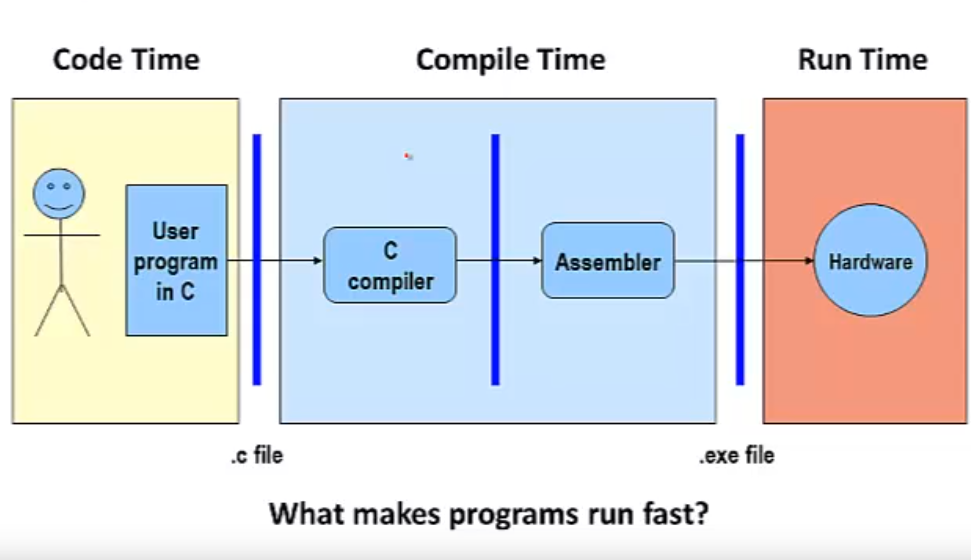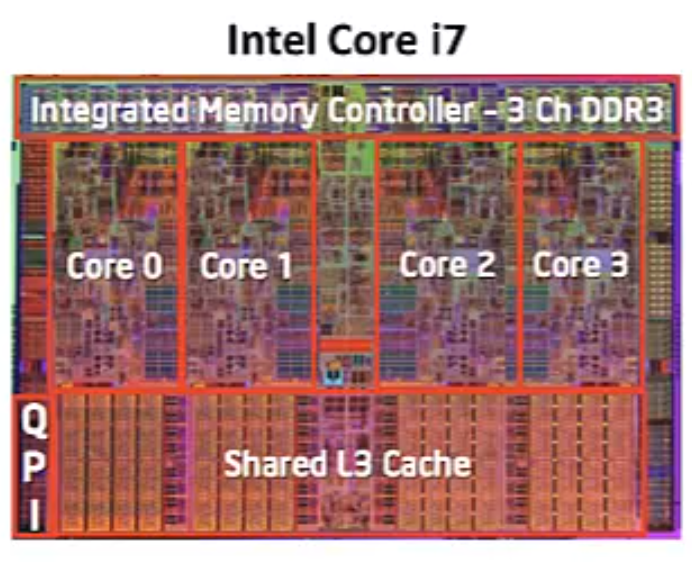Architecture
Basics of architecture, machine programming
- What is an ISA (Instruction Set Architecture)?
- History of Intel processors and architectures
- C, assembly, machine code
- x86 basics: registers
Translation Impacts Performance

Program lifetime illustration
- The time required to execute a program depends on:
- The program.
- The compiler: what set of assember instructions it translates the program into.
- The instruction set architecture (ISA): what set of instructions it makes available to the compiler.
- The hardware implementation: how much time it takes to execute an instruction.
Instruction Set Architectures
- The ISA defines:
- The system’s state (e.g. registers, memory, program counter)
- The instructions the CPU can execute
- The effect that each of these instructions will have on the system state
General ISA Design Decisions
- Instructions
- What instructions are available? What do they do?
- How are they encoded? (eg 32bits, 64bits)
- Registers
- How many registers are there?
- How wide are they?
- Memory(addressing modes)
- How do you specify a memory location?
x86
- Processors that implement the x86 ISA completely dominate the server, desktop and laptop markets
- Evolutionary design
- Backwards compatibility up until 8086, introduced in 1978
- Added more features as time goes on
- Complex instruction set computer (CISC)
- Many different instructions with many different formats
- But, only small subset encountered with Linux programs
- (as opposed to Reduced Instruction Set Computers (RISC), which use simpler instructions)
- Many different instructions with many different formats
Intel x86 Evolution: Milestones
| Name | Date | Transistors | MHz |
|---|---|---|---|
| 8086 | 1978 | 29k | 5-10 |
- First 16-bit processor. Basis for IBM PC & DOS
- 1MB address space
| Name | Date | Transistors | MHz |
|---|---|---|---|
| 386 | 1985 | 275k | 16-33 |
- First 32 bit processor, referred to as IA32
- Added “flat addressing”
- Capable of running Unix
- 32-bit Linux/gcc targets i386 by default
| Name | Date | Transistors | MHz |
|---|---|---|---|
| Pentium 4F | 2005 | 230M | 2800-3800 |
- First 64-bit Intel x86 processor, referred to as x86-64
Intel x86 Processors
| Machine Evolution | |
|---|---|
| 486 | 1989 |
| Pentium | 1993 |
| Pentium/MMX | 1997 |
| PentiumPro | 1995 |
| Pentium III | 1999 |
| Pentium 4 | 2001 |
| Core 2 Duo | 2006 |
| Core i7 | 2008 |

Added Features
- Instructions to support multimedia operations
- Parallel operations on 1, 2, and 4-byte data
- Instructions to enable more efficient conditional operations
- More cores!
References for Intel processor specifications:
x86 Clones: Advanced Micro Devices(AMD)
Historically
- AMD has followed just behind Intel
- A little bit slower, a lot cheaper
Then
- Recruited top circuit designers from Digital Equipment and other downward trending companies
- Build Opteron: touch competitor to Pentium 4
- Developed x86-64, their own extension of x86 to 64 bits
Definitions
- Architecture: (also instruction set architecture or ISA):
- The parts of a processor design that one needs to understand to write assembly code
- “What is directly visible to software”
- Microarchitecture: Implementation of the architecture
- Is cache size “architecture”? No
- How about core frequency? Microarchitecture
- And number of registers? Yes, part of ISA
Assembly Programmer’s View

Programmer-Visible State
- PC: Program counter
- Address of next instruction
- Called “EIP” in (IA32) or “RIP” in (x86-64)
- Register file
- Heavily used program data
- Condition codes
- Store status information about most recent arithmetic operation
- Used for conditional branching Memory
- Byte addressable array
- Code, user data, (some) OS data
- Includes stack used to support procedures
Turning C into Object Code
- Code in files
p1.cp2.c - Compile with command: gcc -O1 p1.c p2.c -o p
- Use basic optimizations (-O1)
- Put resulting binary in file p
Compiling Into Assembly
C Code
int sum(int x, int y)
{
int t = x + y;
return t;
}
Generated IA32 Assembly
sum:
push1 %ebp
mov1 %esp, %ebp
mov1 12(%ebp), %eax
addl 8(%ebp), %eax
mov1 %ebp, %esp
popl %ebp
ret
Obtain with command
gcc -O1 -S code.c
Produces file code.s that holds the assembly code
Three Basic Kinds of Assembly Instructions
- Perform arithmetic function on register or memory data
- Transfer data between memory and register
- Load data from memory into register
- Store register data into memory
- Transfer control
- Unconditional jumps to/from procedures
- Conditional branches
Assembly Characteristics: Data Types
- Integer data of 1, 2, 4 (IA32), or 8 (just in x86-64) bytes
- Data values
- Addresses (untyped pointers)
- Floating point data of 4, 8, or 10 bytes
- What about “aggregate types such as arrays or structs?
- No aggregate types, just contiguously allocated bytes in memory.
Object Code
Code for sum
0x401040 <sum>:
0x55
0x89
0xe5
0x8b
0x45
0x0c
0x03
0x45
0x08
0x89
0xec
0x5d
0xc3
- Total of 13 bytes
- Each instruction 1,2, or 3 bytes
- Starts at address
0x401040 - Not at all obvious where each instruction starts and ends
Assembly
- Translates
.sto.o - Binary encoding of each instruction
- Nearly-complete image of executable code
- Missing links between code in different files
Linker
- Resolves references between object files and (re)locates their data
- Combines with static run-time libraries
- E.g, code for
malloc, printf
- E.g, code for
- Some libraries are
dynamically linked- Linking occurs when program begins execution
Machine Instruction Example
int t = x + y;
addl 8(%ebp), %eax
-
Similar to expression:
x += y -
More precisely:
int eax; int *ebp; eax += ebp[2] -
C Code: add two signed integers
-
Assembly
- Add two 4-byte integers
- Long words in GCC speak
- Same instruction whether signed or unsigned
- Operands:
- x: Register
%eax - y: Memory
m[%ebp+8] - t: Register
%eax- Return function value in
%eax
- Return function value in
- x: Register
- Add two 4-byte integers
-
Object Code
ox401046: 03 45 08
- 3-byte instruction
- Stored at address
0x401046
Disassembling Object Code
- Disassembled

Disassembler
objdump -d p
- Useful tool for examining object code (
man 1 objdump) - Analyzes bit pattern of series of instructions (delineates instructions)
- Produces near-exact rendition of assembly code
- Can be run on either
p(complete executable) orp1.o/p2.ofile
Alternative Disassembly
Object
0x401040 <sum>:
0x55
0x89
0xe5
0x8b
0x45
0x0c
0x03
0x45
0x08
0x89
0xec
0x5d
0xc3
Disassembled
0x401040 <sum>: push %ebp
0x401041 <sum+1>: mov %esp,%ebp
0x401043 <sum+3>: mov 0xc(%ebp),%eax
0x401046 <sum+6>: add 0x8(%ebp),%eax
0x401049 <sum+9>: mov %ebp,%esp
0x40104b <sum+11>: pop %ebp
0x40104c <sum+12>: ret
Within gdb debugger
gdb p
disassemble sum
(disassemble function)
x/13b sum
(examine the 13 bytes starting at sum)
What can be disassembled?
- Anything that can be interpreted as executable code
- Disassembler examines bytes and reconstructs assembly source
Registers
- A location in the CPU that stores a small amount of data, which can be accessed very quickly (once every clock cycle)
- Registers are at the heart of assembly programming
- They are a precious commodity in all architectures, but especially x86
Integer Registers (IA32)
- IA32 has 8 registers. 6 are general purpose and 2 special purpose(the last 2)
| Register | Size(32-bit) | Usage (mostly obsolete) |
|---|---|---|
| %eax | 32 | Accumulator for operands and results data |
| %ecx | 32 | Counter for string and loop operations |
| %edx | 32 | I/O pointer |
| %ebx | 32 | Pointer to data in the data segment |
| %esi | 32 | Source pointer for string operations |
| %edi | 32 | Destination pointer for string operations |
| %esp | 32 | Stack pointer |
| %ebp | 32 | Pointer to the base of the current stack frame |
IA-32 General Purpose Registers (with 16-bit backward compatibility)
| 32-bit Register | 16-bit (BC) | High 8-bit | Low 8-bit |
|---|---|---|---|
| %eax | %ax | %ah | %al |
| %ebx | %bx | %bh | %bl |
| %ecx | %cx | %ch | %cl |
| %edx | %dx | %dh | %dl |
| %esi | %si | ||
| %edi | %di | ||
| %esp | %sp | ||
| %ebp | %bp |
x86-64 Integer Registers
x86-64 Registers
| 64-bit | 32-bit |
|---|---|
| %rax | %eax |
| %rbx | %ebx |
| %rcx | %ecx |
| %rdx | %edx |
| %rsi | %esi |
| %rdi | %edi |
| %rsp | %esp |
| %rbp | %ebp |
| %r8 | %r8d |
| %r9 | %r9d |
| %r10 | %r10d |
| %r11 | %r11d |
| %r12 | %r12d |
| %r13 | %r13d |
| %r14 | %r14d |
| %r15 | %r15d |
- Extend existing registers, and add 8 new ones; all accessible as 8, 16, 32, 64
Summary: Machine Programming
- What is an ISA (Instruction Set Architecture)
- Defines the system’s state and instructions that are available to the software
- History of Intel processors and architectures
- Evolutionary design leads to many quirks and artifacts
- C, assembly, machine code
- Compiler must transform statements, expressions, procedures into low level instruction sequences
- x86 registers
- Very limited number
- Not all general-purpose